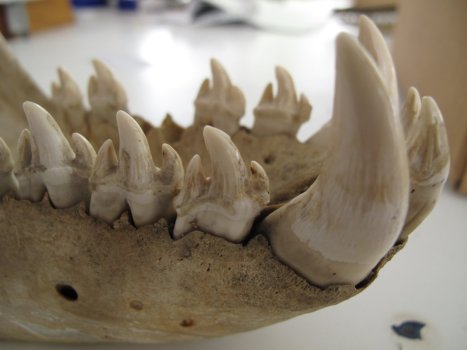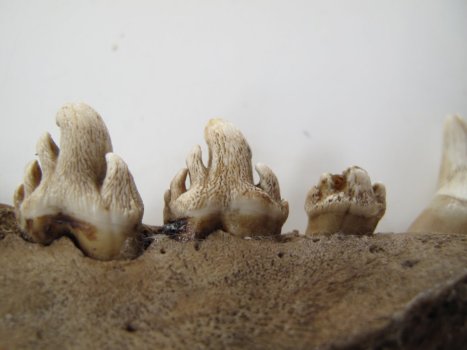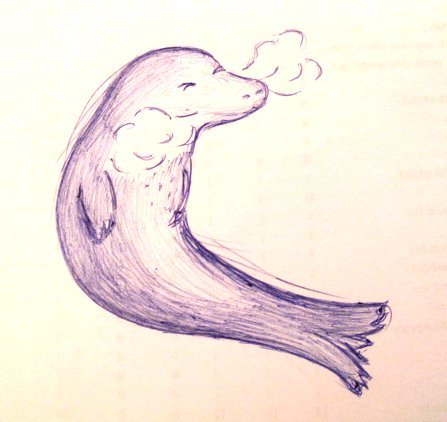Feeding at both ends of the food chain
In terrestrial environments, predator body size is largely correlated with prey body size. The opposite is found for many predators in the marine environment – baleen whales in particular comprise some of the world’s largest mammals and yet they feed on something far smaller (plankton). The leopard seal is unusual in that it feeds both at the top and at the bottom of the food chain, consuming large prey, such as penguins and other seals, and small prey, such as krill, an abundant basal component of the Antarctic food web. While leopard seals are well known as raptorial predators with a ‘grip and tear’ feeding styles, a large portion of their diet (krill) is too small to be eaten in this way. For this, they use filter feeding to separate the krill from seawater.
You can tell a lot about the leopard seal’s diet from its dentition. The presence of heterogeneous teeth is often an indicator of generalist or opportunist feeding strategies, as specific dentition is suitable for handling particular prey types. We know that leopard seals are not generalists, but something of polarised specialists, with incisors specialised to capture large mammalian (and other large) prey and forked cheek (post canine) teeth for sieving out small prey (krill). Crabeater seals have the same adaptation and despite their names, the vast majority of their diet is comprised of krill.


In order to better understand their feeding strategies, Dr. David Hocking monitored the feeding habits of a pair of captive leopard seals when given small prey (chopped fish). The leopard seals made a raised head-strike towards their prey before sucking it into their mouth. Hocking hypothesised that this might let them feed more effectively on small schooling prey, such as krill and when testing this observed – for the first time ever – that leopard seals sieve their prey. After sucking their meal into their mouth, a leopard seal parts its lips and expels seawater at the back of the jaw (where the cheek teeth are located), sending turbulent jets of seawater through their dental sieve and retaining the prey inside.
What’s more, the lack of abrasion on their cheek teeth shows that these aren’t used for aggressive feeding (which would result in greater wear). Likewise, the heavy abrasion on their incisors corresponds to raptorial feeding. Captive crabeater seals have also been seen to suck prey out of a channel half a metre long, an ability that may help them acquire over-wintering krill from crevices (during the winter months krill are less prevalent in the water column and take shelter in crevices within ice floes).
So how do they force out the seawater? There is the possibility that they use their tongue to hold the prey in place as they expel seawater, but if this were the case there would be nothing to force the water out. Instead, Hocking suggests they push the seawater out through forked teeth (an excellent strainer) using their tongue.

While it’s difficult to extrapolate the findings from a pair of seals to an entire species, these results are a promising venture into understanding the feeding ecology of leopard seals.
Reference:
Hocking DP, Evans AR and Fitzgerald EM (2013) Leopard seals (Hydrurga leptonyx) use suction and filter feeding when hunting small prey underwater. Polar Biology, Vol. 36, pp. 211-222.
Great drawing of Sabine!!